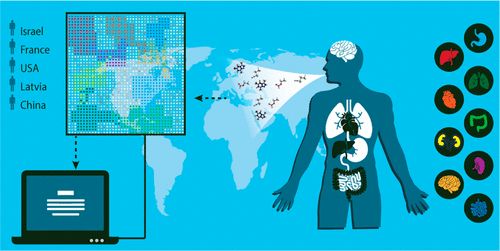Nanoarray sniffs out and distinguishes multiple diseases

Before modern medical lab techniques became available, doctors diagnosed some diseases by smelling a patient's breath. Scientists have been working for years to develop analytical instruments that can mimic this sniff-and-diagnose ability. Now, researchers report in the journal ACS Nano that they have identified a unique "breathprint" for each disease. Using this information, they have designed a device that screens breath samples to classify and diagnose several types of diseases.
Exhaled breath contains nitrogen, carbon dioxide and oxygen, as well as a small amount of more than 100 other volatile chemical components. The relative amounts of these substances vary depending on the state of a person's health. As far back as around 400 B.C., Hippocrates told his students to "smell your patients' breath" to search for clues of diseases such as diabetes (which creates a sweet smell). In more recent times, several teams of scientists have developed experimental breath analyzers, but most of these instruments focus on a single type of disease, such as cancer. In their own work, Hossam Haick and a team of collaborators in 14 clinical departments worldwide wanted to create a breathalyzer that could distinguish among multiple diseases.
The researchers developed an array of nanoscale sensors to detect the individual components in thousands of breath samples from patients who were either healthy or had one of 17 different diseases, such as kidney cancer or Parkinson's disease. By analyzing the results with artificial intelligence techniques, the team could use the array to classify and diagnose the conditions. The team used mass spectrometry to identify the breath components associated with the diseases. They found that each disease produces a unique volatile chemical breathprint, based on differing amounts of 13 components. They also showed that the presence of one disease would not prevent the detection of others - a prerequisite for developing a practical device to screen and diagnose various diseases in a noninvasive, inexpensive and portable manner.
More information: Diagnosis and Classification of 17 Diseases from 1404 Subjects via Pattern Analysis of Exhaled Molecules, ACS Nano, Article ASAP, pubs.acs.org/doi/full/10.1021/acsnano.6b04930
Abstract
We report on an artificially intelligent nanoarray based on molecularly modified gold nanoparticles and a random network of single-walled carbon nanotubes for noninvasive diagnosis and classification of a number of diseases from exhaled breath. The performance of this artificially intelligent nanoarray was clinically assessed on breath samples collected from 1404 subjects having one of 17 different disease conditions included in the study or having no evidence of any disease (healthy controls). Blind experiments showed that 86% accuracy could be achieved with the artificially intelligent nanoarray, allowing both detection and discrimination between the different disease conditions examined. Analysis of the artificially intelligent nanoarray also showed that each disease has its own unique breathprint, and that the presence of one disease would not screen out others. Cluster analysis showed a reasonable classification power of diseases from the same categories. The effect of confounding clinical and environmental factors on the performance of the nanoarray did not significantly alter the obtained results. The diagnosis and classification power of the nanoarray was also validated by an independent analytical technique, i.e., gas chromatography linked with mass spectrometry. This analysis found that 13 exhaled chemical species, called volatile organic compounds, are associated with certain diseases, and the composition of this assembly of volatile organic compounds differs from one disease to another. Overall, these findings could contribute to one of the most important criteria for successful health intervention in the modern era, viz. easy-to-use, inexpensive (affordable), and miniaturized tools that could also be used for personalized screening, diagnosis, and follow-up of a number of diseases, which can clearly be extended by further development.
Journal information: ACS Nano
Provided by American Chemical Society



















